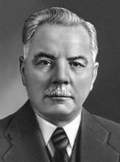| Kliment Vorošilov joined the Bolshevik party in 1903 and participated in the civil war in Russia. In 1918-1919, he was a member of the Ukrainian workers' and peasant's provisional government and people's commissar for internal affairs of the Ukrainian SSR. Organizing the defense of Tsaritsyn against the White Army, he became closely associated with Iosif Stalin, who used Vorošilov's image as brave military commander for propaganda. Lacking strong political ambitions, Vorošilov with the support of Stalin was elected full member of the party Central Committee (1921-1961) and full member of the Orgburo (2 Jun 1924 - 18 Dec 1925). After the death of Mihail Frunze, he was appointed people's commissar for military and navy affairs and chairman of the Revolutionary Military Council of the USSR (6 Nov 1925 - 20 Jun 1934). The Central Committee, elected at the 14th party congress, made him full member of the Politburo (1 Jan 1926 - 5 Oct 1952). In 1934, he was appointed people's commissar for defense of the USSR (20 Jun 1934 - 7 May 1940) and named Marshal of the Soviet Union (1935). He was removed from his post as defence commissar for serious faults in the Russo-Finnish war (1939-1940), but took the office of deputy chairman of the USSR Council of People's Commissars (7 May 1940 - 15 Mar 1946). During the World War II, Vorošilov was a member of the State Defense Committee (30 Jun 1941 - 21 Nov 1944). He was made commander of the northwest armies (10 Jul 1941 - 31 Aug 1941), but failed to prevent the Germans from blockading Leningrad and was barred from further handling of military affairs. Acting as Stalin's representative (1945-1947), Vorošilov supervised the establishment of the communist regime in Hungary in capacity of Chairman of the Allied Control Commission. In the course of reorganization of the people's commissariats into ministries, Vorošilov retained the post of deputy head of the Soviet government as deputy chairman of the Council of Ministers of the USSR (19 Mar 1946 - 15 Mar 1953). Following the 19th party congress, Vorošilov was elected to Presidium of the party Central Committee (16 Oct 1952 - 16 Jul 1960). The death of Stalin prompted a major rotation in the Soviet leadership and on 15 Mar 1953, Vorošilov left his office in the government and was approved as Chairman of the Presidium of the USSR Supreme Soviet. He joined a coalition of Georgij Malenkov and Nikita Hruščëv, which engineered arrest and condemnation of Lavrentij Berija (1953). Vorošilov feared exposing the executions of the Great Purge of the 1930s, in which he was personally involved, and opposed Hruščëv's initiative to make it known at the 20th party congress (1956). Then he joined the conservative members of the party's Presidium, Malenkov, Kaganovič and Molotov, in an unsuccessful attempt to remove Hruščëv from power (June 1957), but soon switched sides and climbed on the bandwagon of Hruščëv's faction. His doubtful loyalty to the new regime prompted his removal from the position of titular haed of the Soviet state (7 May 1960); Supreme Soviet granted his request for retirement and elected Leonid Brežnev chairman of the Presidium. He also lost his seats on the Central Committee Presidium (16 Jul 1960) and Central Committee (Oct 1961). After the downfall of Hruščëv, Brežnev returned Vorošilov into politics, mainly as a symbol of Soviet history. He was again elected to the Central Committee (1966-1969) and was awarded with the second medal of Hero of the Soviet Union (1968). Biography source: [3, pp. 258-259] |

